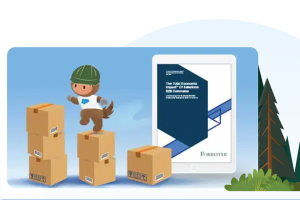The ‘age of the customer’ has found businesses scrambling to keep up with the new needs and expectations of their customers, as personalised service, highly relevant communications, and seamless customer journeys have become standard. Today’s B2B customers now expect the same exceptional e-commerce experience that they receive from B2C businesses, and B2B and B2C organisations are accelerating their digital transformation roadmaps to stay ahead.
Offering a D2C e-commerce channel that complements selling via channel partners and traditional retail may have once been looked at as an add-on for B2B organisations, but it’s increasingly becoming an imperative. After all, new strategies are emerging in the battle for consumer loyalty, and the winners will be the ones who leverage data and new digital technologies, respond quickly to market shifts, and build the best direct relationships with their customers.
To find out how organisations can get ahead in this new environment, Salesforce commissioned Forrester Consulting to conduct a study examining the ROI that could potentially be realised by deploying Commerce Cloud to go direct-to-consumer. The findings are detailed in the new Forrester Report, the Total Economic Impact of Salesforce Commerce Cloud Direct to Consumer.
Let’s have a look at some of the key findings of the report to see how businesses can best use D2C to grow revenue, introduce new selling models like subscriptions, rapidly enter new markets, optimise channel performance, and tap into long-term growth by building close, direct relationships with their customers.
Control the customer experience with D2C e-commerce
Prior to adopting Commerce Cloud, the organisations interviewed in the Forrester report used other vendors to maintain their e-commerce platform or conducted D2C e-commerce through third-party online marketplaces. This meant that they had little control over the quality of the customer experience, could not reach out with tailored promotions, and were unable to match the right customer with the right offer at the right time.
Fragmented data also meant that they were not getting a complete view of their audience. Without this 360-degree view, companies struggled to meet their customers’ needs and expectations for timely and personalised service. This presents a huge problem in a competitive climate where expectations are higher than ever.
After using Salesforce to improve checkout processes, make minor website adjustments and optimise their ecommerce channels, companies saw a notable uptick in the revenue generated by their ecommerce website. Conversion rates increased by 1.5%, leading to $1.1 million in additional revenue. Additionally, thanks to the increased availability of the ecommerce platform during periods of high demand, they saw $1.2 million in savings.
The templates provided in Commerce Cloud also empowered promotions teams to move faster and more efficiently, saving an average of 160 hours per promotion – or $810,000 when converted. This time can be better used for strategic planning and tackling more complex business objectives.
Create New Streams of revenue
The new landscape is driven by having extensive knowledge of the customer, and without having access to accurate data about customer preferences, many organisations will not be able to segment their audience to provide relevant communications and recommendations. It also means that they’ll be slower to respond to shifts in the market and identify emerging new opportunities.
Commerce Cloud provides organisations with an in-depth understanding of the browsing and buying behaviours of consumers who visit their ecommerce sites, allowing them to make changes to create better customer experiences. The Forrester Total Economic Impact report reveals just how important these changes have been for the interviewed companies:
- Using Einstein AI to provide more accurate product recommendations and better search functionality led to an increase of $1.3 million over a three-year period.
- The aggregate company gained an additional $301,000 of revenue from introducing the subscription model, delivering an impressive retention rate of 90% in the first three months, and securing a new and steady revenue stream for the business.
D2C ecommerce is also providing an opportunity for many businesses to increase their ecommerce margins. Prior to using Commerce Cloud, the interviewed organisations used vendors to maintain an e-commerce platform or conducted D2C e-commerce through third-party online marketplaces. As a result, they had little control over the brand experience that was being offered to their customers.
Now, the D2C model is enabling them to recapture some of these costs, driving increased revenue through higher margins. As one business leader said, “With Salesforce, we are finding the right people and connecting them with the right products, which eventually leads them to our subscription model. Once we do that, we are retaining these customers. So, that is one of the keys to our growth”.
Respond to market shifts and scale with ease
Companies that wrangle with legacy systems, the unreliable performance of third-party vendors and cumbersome scaling efforts will find it difficult to consistently meet their revenue growth target. This failure is costly, as each hour of lost downtime costs organisations an average of $250,000 in net profit.
The flexibility of Commerce Cloud allows users to quickly expand their D2C ecommerce offerings to new countries and regions. This has the added benefit of saving time for the individuals responsible for expanding an organisation’s market presence, as well as increasing revenue faster than ever before. In fact, the Forrester report shows that the increase in availability during peak traffic hours has resulted in an additional $1.2 million in revenue.
The digital marketing ecommerce manager of one of the interviewed organisations stated: “Scalability is a strength of Commerce Cloud; we’ve had product drops where we’ve had tens of thousands of people on the site per second. We’ve had periods of time where we did 15% to 20% of our sales for the year in the mere span of 2 hours with no interruption in our site availability.”
D2C builds customer engagement and better relationships
Offering a D2C channel is the best way for businesses to take control of their customer experience and increase customer engagement. It empowers enterprises to deliver tailored communications and personalised service, leading to longer, more meaningful relationships. And, not only can D2C ecommerce lead to happier customers; but it can also drive revenue, increase productivity and optimise the workforce.
With so many short-term and strategic long-term benefits – and the increasingly high bar for service in the new normal – the time to introduce a D2C channel is now. Download the full Forrester report to see how D2C can take your business to exciting new places; then turbo-charge your digital transformation today.
You can watch our webinar with Forrester Consulting to learn more about the Total Economic Impact of Salesforce B2B Commerce, and then download the full report here.





















